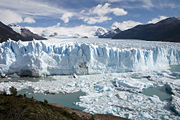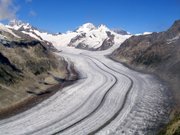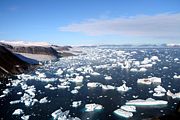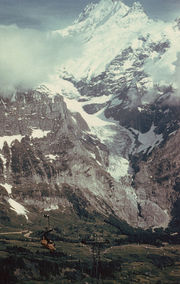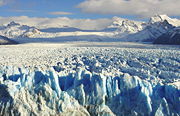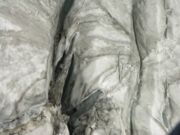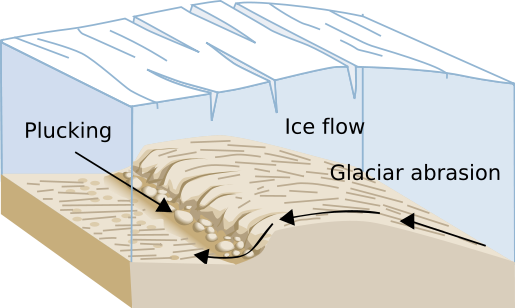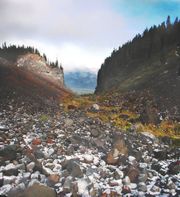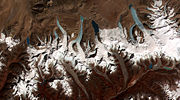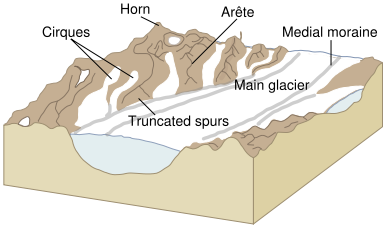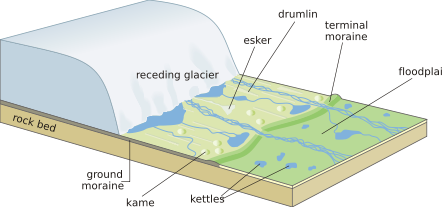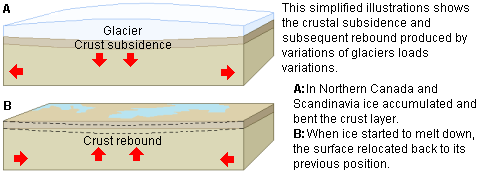Glacier
2008/9 Schools Wikipedia Selection. Related subjects: Geography
- "Glacial" and "Glaciation" redirect here. For the geological periods, see glacial period. For the story by Alastair Reynolds, see Glacial (short story).
A glacier is a large, slow-moving river of ice, formed from compacted layers of snow, that slowly deforms and flows in response to gravity and high pressure. The processes and landforms caused by glaciers and related to them are glacial ( adjective); this term should not be confounded with glacial ( noun), a cold period in ice ages (see glacial period). The process of glacier growth and establishment is called glaciation.
The word glacier comes from French via the Vulgar Latin glacia, and ultimately from Latin glacies meaning ice.
Overview
Glacier ice is the largest reservoir of fresh water on Earth, and second only to oceans as the largest reservoir of total water. Glaciers cover vast areas of polar regions but are restricted to the highest mountains in the tropics.
Many geomorphological processes are interrupted or modified significantly by glaciers. Geomorphological features created by glaciers include end, lateral, ground and medial moraines that form from glacially transported rocks and debris; U-shaped valleys and cirques at their heads, and the glacier fringe, which is the area where the glacier has recently melted into water. Much precipitation becomes trapped in the glaciers instead of flowing immediately back to the oceans, causing sea level drops and greatly modifying the hydrology of streams. The Earth's crust is pushed down by the weight of the ice, and meltwater commonly collects and forms lakes along the ice margins.
Glacial epochs have come and gone repeatedly over the last million years. Presently, Earth is in a relatively warm period, called an interglacial, exacerbated by global warming with the resulting retreat of the glaciers. The Earth has been cyclically plunged into cold episodes, however, called glacials, in which the extent of glaciers is expanded, colloquially referred to as ice ages.
Types of glaciers

There are two main types of glaciers: alpine glaciers, which are found in mountain terrains, and continental glaciers, which can cover larger areas. Most of the concepts in this article apply equally to alpine glaciers and continental glaciers.
A temperate glacier is at melting point throughout the year, from its surface to its base. The ice of polar glaciers is always below freezing point with most mass loss due to sublimation. Sub-polar glaciers have a seasonal zone of melting near the surface and have some internal drainage, but little to no basal melt.
Thermal classifications of surface conditions vary, so glacier zones are often used to identify melt conditions. The dry snow zone is a region where no melt occurs, even in the summer. The percolation zone is an area with some surface melt, and meltwater percolating into the snowpack, often this zone is marked by refrozen ice lenses, glands, and layers. The wet snow zone is the region where all of the snow deposited since the end of the previous summer has been raised to 0°C. The superimposed ice zone is a zone where meltwater refreezes as a cold layer in the glacier forming a continuous mass of ice.
The smallest alpine glaciers form in mountain valleys and are referred to as valley glaciers. Larger glaciers can cover an entire mountain, mountain chain or even a volcano; this type is known as an ice cap. Ice caps feed outlet glaciers, tongues of ice that extend into valleys below, far from the margins of those larger ice masses. Outlet glaciers are formed by the movement of ice from a polar ice cap, or an ice cap from mountainous regions, to the sea.
The largest glaciers are continental ice sheets, enormous masses of ice that are not visibly affected by the landscape and that cover the entire surface beneath them, except possibly on the margins where they are thinnest. Antarctica and Greenland are the only places where continental ice sheets currently exist. These regions contain vast quantities of fresh water. The volume of ice is so large that if the Greenland ice sheet melted, it would cause sea levels to rise some six meters (20 ft) all around the world. If the Antarctic ice sheet melted, sea levels would rise up to 65 meters (210 ft).
Plateau glaciers resemble ice sheets, but on a smaller scale. They cover some plateaus and high-altitude areas. This type of glacier appears in many places, especially in Iceland and some of the large islands in the Arctic Ocean, and throughout the northern Pacific Cordillera from southern British Columbia to western Alaska.
Tidewater glaciers are glaciers that flow into the sea. As the ice reaches the sea pieces break off, or calve, forming icebergs. Most tidewater glaciers calve above sea level, which often results in a tremendous splash as the iceberg strikes the water. If the water is deep, glaciers can calve underwater, causing the iceberg to suddenly explode up out of the water. The Hubbard Glacier is the longest tidewater glacier in Alaska and has a calving face over ten kilometers long. Yakutat Bay and Glacier Bay are both popular with cruise ship passengers because of the huge glaciers descending hundreds of feet to the water. This glacier type undergoes centuries-long cycles of advance and retreat that are much less affected by the climate changes currently causing the retreat of most other glaciers.
Formation
The snow which forms temperate glaciers is subject to repeated freezing and thawing, which changes it into a form of granular ice called névé. Under the pressure of the layers of ice and snow above it, this granular ice fuses into denser firn. Over a period of years, layers of firn undergo further compaction and become glacial ice. In addition, a few hours after deposition, snow will begin to undergo metamorphism because of the presence of temperature gradients and/or convex and concave surfaces within individual crystals (causing differential vapour pressure). This causes the sublimation of ice from smaller crystals and the deposition of water vapour onto larger crystals, so many crystals become progressively more rounded over time. Depending on the type of metamorphism, the snowpack may become stronger or weaker as a result.
The distinctive blue tint of glacial ice is often wrongly attributed to Rayleigh scattering which is supposedly due to bubbles in the ice. The blue colour is actually created for the same reason that water is blue, that is, its slight absorption of red light due to an overtone of the infrared OH stretching mode of the water molecule .
The lower layers of glacial ice flow and deform plastically under the pressure, allowing the glacier as a whole to move slowly like a viscous fluid. Glaciers usually flow downslope, although they do not need a surface slope to flow, as they can be driven by the continuing accumulation of new snow at their source, creating thicker ice and a surface slope. The upper layers of glaciers are more brittle, and often form deep cracks known as crevasses or bergschrunds as they move.
Crevasses form due to internal differences in glacier velocity between two quasi-rigid parts above the deeper more plastic substrate far below. As the parts move at different speeds and directions, shear forces cause the two sections to break apart opening the crack of a crevasse all along the disconnecting faces. Projected in effect over three dimensions, one may settle and tip, the other upthrust or twist, or all such combinations due to the effects of each floating on the plastic layers below and any contact with rock and such. Hence the distance between the two separated parts while touching and rubbing deep down, frequently widens significantly towards the surface layers, many times creating a wide chasm.
These crevasses make travel over glaciers hazardous. Subsequent heavy snow may form a fragile snow bridge, increasing the danger by hiding their presence at the surface. Glacial meltwaters flow throughout and underneath glaciers, carving channels in the ice (called moulins) similar to cave formation through rock and also helping to lubricate the glacier's movement.
Anatomy
The upper part of a glacier that receives most of the snowfall is called the accumulation zone. In general, the accumulation zone accounts for 60-70% of the glacier's surface area. The depth of ice in the accumulation zone exerts a downward force sufficient to cause deep erosion of the rock in this area. After the glacier is gone, this often leaves a bowl or amphitheater-shaped isostatic depression called a cirque.
On the opposite end of the glacier, at its foot or terminal, is the deposition or ablation zone, where more ice is lost through melting than gained from snowfall and sediment is deposited. The place where the glacier thins to nothing is called the ice front.
The altitude where the two zones meet is called the equilibrium line, also called the snow line. At this altitude, the amount of new snow gained by accumulation is equal to the amount of ice lost through ablation. Due to erosive forces at the edges of the moving ice, glaciers turn V-shaped river-carved valleys into U-shaped glacial valleys.
The "health" of a glacier is defined by the area of the accumulation zone compared to the ablation zone. When directly measured this is glacier mass balance. Healthy glaciers have large accumulation zones. Several non-linear relationships define the relation between accumulation and ablation.
In the aftermath of the Little Ice Age, around 1850, the glaciers of the Earth have retreated substantially. Glacier retreat has increased since the 1980s, the coldest decade since 1900.
Occurrence
Glaciers occur on every continent and in approximately 47 of the world's countries. Extensive glaciers are found in Antarctica, Patagonia, Canada, Greenland and Iceland. Mountain glaciers are widespread e.g. in the Andes, the Himalaya, the Rocky Mountains, the Caucasus, the Alps, the Pyrenees, in Norway, Japan, Turkey and the Iran. On mainland Australia no glaciers exist today, although a small glacier on Mount Kosciuszko was present in the last glacial period, and Tasmania was widely glaciated. On New Zealand's South Island the West Coast bears the Fox and Franz Josef Glaciers. In New Guinea small glaciers are located on its highest summit massif of Puncak Jaya. Africa has glaciers on Mount Kilimanjaro in Tanzania, on Mount Kenya and in the Ruwenzori Range.
Permanent snow cover is affected by factors such as the degree of slope on the land, amount of snowfall and the force and nature of the winds. As temperature decreases with altitude, high mountains — even those near the Equator — have permanent snow cover on their upper portions, above the snow line. Examples include Mount Kilimanjaro and the Tropical Andes in South America; however, the only snow to occur exactly on the Equator is at 4,690 m (15,387 ft) on the southern slope of Volcán Cayambe in Ecuador.
Conversely, many regions of the Arctic and Antarctic receive very little precipitation and therefore experience little snowfall despite the bitter cold (cold air, unlike warm air, cannot take away much water vapor from the sea). In Antarctica, the snow does not melt even at sea level. In addition to the dry, unglaciated regions of the Arctic, there are some mountains and volcanoes in Bolivia, Chile and Argentina that are high (4,500 metres (14,800 ft) - 6,900 m (22,600 ft)) and cold, but the relative lack of precipitation prevents snow from accumulating into glaciers. This is because these peaks are located near or in the hyperarid Atacama desert. Further examples of these temperate unglaciated mountains is the Kunlun Mountains, Tibet and the Pamir Range to the north of the Himalayas in Central Asia. Here, just like the Andes, mountains in Central Asia can reach above 6,000 m (20,000 ft) and be barren of snow and ice due to the rain shadow effect caused by the taller Himalaya Range.
During glacial periods of the Quaternary, most of Siberia, central and northern Alaska and all of Manchuria, were similarly too dry to support glaciers, though temperatures were as low as or lower than in glaciated areas of Europe and North America. This was because dry westerly winds from ice sheets in Europe and the coastal ranges in North America reduced precipitation to such an extent that glaciers could never develop except on a few high mountains like the Verkhoyansk Range (which still supports glaciers today).
Glaciers on Mars
Elsewhere in the solar system, the vast polar ice caps of Mars rival those of the Earth and show glacial features. Especially the south polar cap is compared to glaciers on Earth. Other glacial features on Mars are glacial debris aprons and the lineated valley fills of the fretted terrain in northern Arabia Terra. Topographical features and computer models indicate the existence of more glaciers in Mars' past.
Motion
Glaciers have a tendency to move, or "flow", downhill. While the bulk of a glacier flows in the direction of lower elevation, every point of the glacier can move at a different rate, and in a different direction. The general motion is due to the force of gravity, and the rate of flow at each point on the glacier is affected by many factors.
Ice behaves like an easily breaking solid until its thickness exceeds about 50 meters (160 ft). The pressure on ice deeper than that depth causes plastic flow. The glacial ice is made up of layers of molecules stacked on top of each other, with relatively weak bonds between the layers. When the stress of the layer above exceeds the inter-layer binding strength, it moves faster than the layer below.
Another type of movement is basal sliding. In this process, the whole glacier moves over the terrain on which it sits, lubricated by meltwater. As the pressure increases toward the base of the glacier, the melting point of water decreases, and the ice melts. Friction between ice and rock and geothermal heat from the Earth's interior also contribute to thawing. This type of movement is dominant in temperate glaciers. The geothermal heat flux becomes more important the thicker a glacier becomes.
Fracture zone and cracks
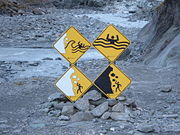
The top 50 meters of the glacier are more rigid. In this section, known as the fracture zone, the ice mostly moves as a single unit. Ice in the fracture zone moves over the top of the lower section. When the glacier moves through irregular terrain, cracks form in the fracture zone. These cracks can be up to 50 meters deep, at which point they meet the plastic like flow underneath that seals them.
Speed
The speed of glacial displacement is partly determined by friction. Friction makes the ice at the bottom of the glacier move slower than the upper portion. In alpine glaciers, friction is also generated at the valley's side walls, which slows the edges relative to the center. This was confirmed by experiments in the 19th century, in which stakes were planted in a line across an alpine glacier, and as time passed, those in the centre moved farther.
Mean speeds vary; some have speeds so slow that trees can establish themselves among the deposited scourings. In other cases they can move as fast as meters per day, as in the case of Antarctica's Byrd Glacier, which moves 750-800 meters per year.
Many glaciers have periods of very rapid advancement called surges. These glaciers exhibit normal movement until suddenly they accelerate, then return to their previous state. During these surges, the glacier may reach velocities far greater than normal speed. These surges may be caused by failure of the underlying bedrock, the ponding of meltwater at the base of the glacier — perhaps delivered from a supraglacial lake — or the simple accumulation of mass beyond a critical "tipping point".
Moraines
Glacial moraines are formed by the deposition of material from a glacier and are exposed after the glacier has retreated. These features usually appear as linear mounds of till, a non-sorted mixture of rock, gravel and boulders within a matrix of a fine powdery material. Terminal or end moraines are formed at the foot or terminal end of a glacier. Lateral moraines are formed on the sides of the glacier. Medial moraines are formed when two different glaciers, flowing in the same direction, coalesce and the lateral moraines of each combine to form a moraine in the middle of the merged glacier. Less apparent is the ground moraine, also called glacial drift, which often blankets the surface underneath much of the glacier downslope from the equilibrium line. Glacial meltwaters contain rock flour, an extremely fine powder ground from the underlying rock by the glacier's movement. Other features formed by glacial deposition include long snake-like ridges formed by streambeds under glaciers, known as eskers, and distinctive streamlined hills, known as drumlins.
Stoss-and-lee erosional features are formed by glaciers and show the direction of their movement. Long linear rock scratches (that follow the glacier's direction of movement) are called glacial striations, and divots in the rock are called chatter marks. Both of these features are left on the surfaces of stationary rock that were once under a glacier and were formed when loose rocks and boulders in the ice were transported over the rock surface. Transport of fine-grained material within a glacier can smooth or polish the surface of rocks, leading to glacial polish. Glacial erratics are rounded boulders that were left by a melting glacier and are often seen perched precariously on exposed rock faces after glacial retreat.
The term moraine is of French origin, and it was coined by peasants to describe alluvial embankments and rims found near the margins of glaciers in the French Alps. In modern geology, the term is used more broadly, and is applied to a series of formations, all of which are composed of till.
Drumlins
Drumlins are asymmetrical, canoe shaped hills with aerodynamic profiles made mainly of till. Their heights vary from 15 to 50 meters and they can reach a kilometer in length. The tilted side of the hill looks toward the direction from which the ice advanced (stoss), while the longer slope follows the ice's direction of movement (lee).
Drumlins are found in groups called drumlin fields or drumlin camps. An example of these fields is found east of Rochester, New York, and it is estimated that it contains about 10,000 drumlins.
Although the process that forms drumlins is not fully understood, it can be inferred from their shape that they are products of the plastic deformation zone of ancient glaciers. It is believed that many drumlins were formed when glaciers advanced over and altered the deposits of earlier glaciers.
Ogives
Ogives are alternating dark and light bands of ice occurring as ridges and valleys on glacier surfaces. They only occur below icefalls but not all icefalls have ogives below them. Once formed, they bend progressively downglacier due to the increased velocity toward the glacier's centerline. Ogives are likely linked to seasonal motion of the glacier as the width of one dark and one light band generally equals the annual movement of the glacier. The ridges and valleys are formed because ice from an icefall is severely broken up thereby increasing ablation surface area during the summertime creating a swale and creating space for snow accumulation in the winter creating a ridge. Sometimes ogives are described as either wave ogives or band ogives in which they are solely undulations or varying colour bands respectively.
Erosion
Rocks and sediments are added to glaciers through various processes. Glaciers erode the terrain principally through two methods: abrasion and plucking.
As the glacier flows over the bedrock's fractured surface, it softens and lifts blocks of rock that are brought into the ice. This process is known as plucking, and it is produced when subglacial water penetrates the fractures and the subsequent freezing expansion separates them from the bedrock. When the water expands, it acts as a lever that loosens the rock by lifting it. This way, sediments of all sizes become part of the glacier's load.
Abrasion occurs when the ice and the load of rock fragments slide over the bedrock and function as sandpaper that smooths and polishes the surface situated below. This pulverized rock is called rock flour. This flour is formed by rock grains of a size between 0.002 and 0.00625 mm. Sometimes the amount of rock flour produced is so high that currents of meltwaters acquire a grayish colour.
Another of the visible characteristics of glacial erosion are glacial striations. These are produced when the bottom's ice contains large chunks of rock that mark trenches in the bedrock. By mapping the direction of the flutes the direction of the glacier's movement can be determined. Chatter marks are seen as lines of roughly crescent shape depressions in the rock underlying a glacier caused by the abrasion where a boulder in the ice catches and is then released repetitively as the glacier drags it over the underlying basal rock.
A glacier may also erode its environment through katabatic winds.
The rate of glacier erosion is variable. The differential erosion undertaken by the ice is controlled by six important factors:
- Velocity of glacial movement
- Thickness of the ice
- Shape, abundance and hardness of rock fragments contained in the ice at the bottom of the glacier
- Relative ease of erosion of the surface under the glacier.
- Thermal conditions at the glacier base.
- Permeability and water pressure at the glacier base.
Material that becomes incorporated in a glacier are typically carried as far as the zone of ablation before being deposited. Glacial deposits are of two distinct types:
- Glacial till: material directly deposited from glacial ice. Till includes a mixture of undifferentiated material ranging from clay size to boulders, the usual composition of a moraine.
- Fluvial and outwash: sediments deposited by water. These deposits are stratified through various processes, such as boulders being separated from finer particles.
The larger pieces of rock which are encrusted in till or deposited on the surface are called glacial erratics. They may range in size from pebbles to boulders, but as they may be moved great distances they may be of drastically different type than the material upon which they are found. Patterns of glacial erratics provide clues of past glacial motions.
Glacial valleys
Before glaciation, mountain valleys have a characteristic "V" shape, produced by downward erosion by water. However, during glaciation, these valleys widen and deepen, forming a "U"-shaped glacial valley. Besides the deepening and widening of the valley, the glacier also smooths the valley due to erosion. In this way, it eliminates the spurs of earth that extend across the valley. Because of this interaction, triangular cliffs called truncated spurs are formed.
Many glaciers deepen their valleys more than their smaller tributaries. Therefore, when the glaciers recede from the region, the valleys of the tributary glaciers remain above the main glacier's depression, and these are called hanging valleys.
In parts of the soil that were affected by abrasion and plucking, the depressions left can be filled by lakes, called paternoster lakes.
At the 'start' of a classic valley glacier is the cirque, which has a bowl shape with escarped walls on three sides, but open on the side that descends into the valley. In the cirque, an accumulation of ice is formed. These begin as irregularities on the side of the mountain, which are later augmented in size by the coining of the ice. Once the glacier melts, these corries are usually occupied by small mountain lakes called tarns.
There may be two glacial cirques 'back to back' which erode deep into their backwalls until only a narrow ridge, called an arête is left. This structure may result in a mountain pass.
Glaciers are also responsible for the creation of fjords (deep coves or inlets) and escarpments that are found at high latitudes.
Arêtes and horns (pyramid peak)
An arête is a narrow crest with a sharp edge. The meeting of three or more arêtes creates pointed pyramidal peaks and in extremely steep-sided forms these are called horns.
Both features may have the same process behind their formation: the enlargement of cirques from glacial plucking and the action of the ice. Horns are formed by cirques that encircle a single mountain.
Arêtes emerge in a similar manner; the only difference is that the cirques are not located in a circle, but rather on opposite sides along a divide. Arêtes can also be produced by the collision of two parallel glaciers. In this case, the glacial tongues cut the divides down to size through erosion, and polish the adjacent valleys.
Sheepback rock
Some rock formations in the path of a glacier are sculpted into small hills with a shape known as roche moutonnée or sheepback. An elongated, rounded, asymmetrical, bedrock knob can be produced by glacier erosion. It has a gentle slope on its up-glacier side and a steep to vertical face on the down-glacier side. The glacier abrades the smooth slope that it flows along, while rock is torn loose from the downstream side and carried away in ice, a process known as 'plucking'. Rock on this side is fractured by combinations of forces due to water, ice in rock cracks, and structural stresses.
Alluvial stratification
The water that rises from the ablation zone moves away from the glacier and carries with it fine eroded sediments. As the speed of the water decreases, so does its capacity to carry objects in suspension. The water then gradually deposits the sediment as it runs, creating an alluvial plain. When this phenomenon occurs in a valley, it is called a valley train. When the deposition is to an estuary, the sediments are known as " bay mud".
Alluvial plains and valley trains are usually accompanied by basins known as kettles. Glacial depressions are also produced in till deposits. These depressions are formed when large ice blocks are stuck in the glacial alluvium and after melting, they leave holes in the sediment.
Generally, the diameter of these depressions does not exceed 2 km, except in Minnesota, where some depressions reach up to 50 km in diameter, with depths varying between 10 and 50 meters.
Deposits in contact with ice
When a glacier reduces in size to a critical point, its flow stops, and the ice becomes stationary. Meanwhile, meltwater flows over, within, and beneath the ice leave stratified alluvial deposits. Because of this, as the ice melts, it leaves stratified deposits in the form of columns, terraces and clusters. These types of deposits are known as deposits in contact with ice.
When those deposits take the form of columns of tipped sides or mounds, which are called kames. Some kames form when meltwater deposits sediments through openings in the interior of the ice. In other cases, they are just the result of fans or deltas towards the exterior of the ice produced by meltwater.
When the glacial ice occupies a valley it can form terraces or kame along the sides of the valley.
A third type of deposit formed in contact with the ice is characterized by long, narrow sinuous crests composed fundamentally of sand and gravel deposited by streams of meltwater flowing within, beneath or on the glacier ice. After the ice has melted these linear ridges or eskers remain as landscape features. Some of these crests have heights exceeding 100 meters and their lengths surpass 100 km.
Loess deposits
Very fine glacial sediments or rock flour is often picked up by wind blowing over the bare surface and may be deposited great distances from the original fluvial deposition site. These eolian loess deposits may be very deep, even hundreds of meters, as in areas of China and the Midwestern United States.
Transportation
- Entrainment is the picking up of loose material by the glacier from along the bed and valley sides. Entrainment can happen by regelation or by the ice simply picking up the debris.
- Basal Ice Freezing is thought to be to be made by glaciohydraulic supercooling, though some studies show that even where physical conditions allow it to occur, the process may not be responsible for observed sequences of basal ice.
- Plucking is the process involves the glacier freezing onto the valley sides and subsequent ice movement pulling away masses of rock. As the bedrock is greater in strength than the glacier, only previously loosened material can be removed. It can be loosened by local pressure and temperature, water and pressure release of the rock itself.
- Supraglacial debris is carried on the surface of the glacier as lateral and medial moraines. In summer ablation, surface melt water carries a small load and this often disappears down crevasses.
- Englacial debris is moraine carried within the body of the glacier.
- Subglacial debris is moved along the floor of the valley either by the ice as ground moraine or by meltwater streams formed by pressure melting.
Deposition
- Lodgement till is identical to ground moraine. It is material that is smeared on to the valley floor when its weight becomes too great to be moved by the glacier.
- Ablation till is a combination of englacial and supraglacial moraine It is released as a stationary glacier begins to melt and material is dropped in situ.
- Dumping is when a glacier moves material to its outermost or lowermost end and dumps it.
- Deformation flow is the change of shape of the rock and land due to the glacier.
Glacial deposition takes place in two forms: glaciofluvial deposition and till deposits.
- Glaciofluvial deposition comes from glacial meltwater. The water that is a result from melting glaciers carry material much like a river would and sorts it is it moves along. Examples of these landforms would include outwash plains and kettle holes.
- Till deposits are unsorted mounds of sand, gravel and rock that form around a glacier. Examples of these are moraines, kame terraces etc.
Isostatic rebound
This rise of a part of the crust is due to an isostatic adjustment. A large mass, such as an ice sheet/glacier, depresses the crust of the Earth and displaces the mantle below. The depression is about a third the thickness of the ice sheet. After the glacier melts the mantle begins to flow back to its original position pushing the crust back to its original position. This post-glacial rebound, which lags melting of the ice sheet/glacier, is currently occurring in measurable amounts in Scandinavia and the Great Lakes region of North America.
An interesting geomorphological feature created by the same process, but on a smaller scale, is known as dilation-faulting. It occurs within rock where previously compressed rock is allowed to return to its original shape, but more rapidly than can be maintained without faulting, leading to an effect similar to that which would be seen if the rock were hit by a large hammer. This can be observed in recently de-glaciated parts of Iceland.
Ice ages
Divisions
A quadruple division of the Quaternary glacial period has been established for North America and Europe. These divisions are based principally on the study of glacial deposits. In North America, each of these four stages was named for the state in which the deposits of these stages were well exposed. In order of appearance, they are the following: Nebraskan, Kansan, Illinoisan, and Wisconsinan. This classification was refined thanks to the detailed study of the sediments of the ocean floor. Because the sediments of the ocean floor are less affected by stratigraphic discontinuities than those on land, they are useful to determine the climatic cycles of the planet.
In this matter, geologists have come to identify over twenty divisions, each of them lasting approximately 100,000 years. All these cycles fall within the Quaternary glacial period.
During its peak, the ice left its mark over almost 30% of Earth's surface, covering approximately 10 million km² in North America, 5 million km² in Europe and 4 million km² in Asia. The glacial ice in the Northern hemisphere was double that found in the Southern hemisphere. This is because southern polar ice cannot advance beyond the Antarctic landmass. It is now believed that the most recent glacial period began between two and three million years ago, in the Pleistocene era.
The last major glacial period began about 2,000,000 years B.P. and is commonly known as the Pleistocene or Ice Age. During this glacial period, large glacial ice sheets covered much of North America, Europe, and Asia for long periods of time. The extent of the glacier ice during the Pleistocene, however, was not static. The Pleistocene had periods when the glaciers retreated (interglacial) because of mild temperatures, and advanced because of colder temperatures (glacial). Average global temperatures were probably 4 to 5° Celsius colder than they are today at the peak of the Pleistocene. The most recent glacial retreat began about 14,000 years B.P. and is still going on. We call this period the Holocene epoch.
Causes
Generalized glaciations have been rare in the history of Earth. However, the Ice Age of the Pleistocene was not the only glacial event, since tillite deposits have been identified. Tillite is a sedimentary rock formed when glacial till is lithified.
These deposits found in strata of differing age present similar characteristics as fragments of fluted rock, and some are superposed over bedrock surfaces of channeled and polished rock or associated with sandstone and conglomerates that have features of alluvial plain deposits.
Two Precambrian glacial episodes have been identified, the first approximately 2 billion years ago, and the second (Snowball Earth) about 650 million years ago. Also, a well documented record of glaciation exists in rocks of the late Paleozoic (the Carboniferous and Permian).
Although there are several scientific hypotheses about the determining factors of glaciations, the two most important ideas are plate tectonics and variations in Earth's orbit (Milankovitch cycles).
Plate tectonics
Because glaciers can form only on dry land, plate tectonics suggest that the evidence of previous glaciations seen in tropical latitudes is due to the drift of tectonic plates from tropical latitudes to circumpolar regions. Evidence of glacial structures in South America, Africa, Australia, and India support this idea, because it is known that they experienced a glacial period near the end of the Paleozoic Era, some 250 million years ago.
The idea that the evidence of middle-latitude glaciations is closely related to the displacement of tectonic plates was confirmed by the absence of glacial traces in the same period for the higher latitudes of North America and Eurasia, which indicates that their locations were very different from today.
Climatic changes are also related to the positions of the continents, which has made them vary in conjunction with the displacement of plates. That also affected ocean current patterns, which caused changes in heat transmission and humidity. Since continents drift very slowly (about 2 cm per year), similar changes occur in periods of millions of years.
A study of marine sediment that contained climatically sensitive microorganisms until about half a million years ago were compared with studies of the geometry of Earth's orbit, and the result was clear: climatic changes are closely related to periods of obliquity, precession, and eccentricity of the Earth's orbit.
In general it can be affirmed that plate tectonics applies to long time periods, while Milankovitch's proposal, backed up by the work of others, adjusts to the periodic alterations of glacial periods of the Pleistocene. In both mechanisms the radiation imbalance of the earth is thought to play a large role in the build-up and melt of glaciers.
